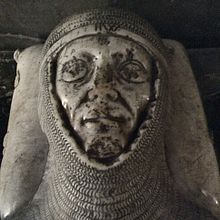Otto de Grandson
Otto de Grandson | |
|---|---|
 Otto I de Grandson, detail from his effigy in Lausanne Cathedral | |
| Born | c. 1238 Lausanne, Savoy |
| Died | 1328 Aigle, Savoy |
| Allegiance | Kingdom of England |
| Service/ | Savoyard knights |
| Rank | Baron Grandison |
| Other work | Lord of the Isles (Channel Islands) |


Otto de Grandson[a] (c. 1238–1328), sometimes numbered Otto I to distinguish him from later members of his family with the same name, was the most prominent of the Savoyard knights in the service of King Edward I of England, to whom he was the closest personal friend and many of whose interests he shared. His misrule of the Channel Islands, particularly after he left England following Edward's death, prompted greater care of the English kings when considering provision of future life estates.
Family
The son of Pierre, lord of Grandson near Lausanne and Agnès de Neuchâtel. He was the elder brother of William de Grandison, 1st Baron Grandison and Henri de Grandson, both of whom would join him in England. As would his cousins Pierre de Champvent and Guillaume de Champvent.
Service in England and Wales (1265–90)
The young Otto travelled to England probably in the company of
Returning to England, he was a key
He was appointed lord of the Channel Islands[4][5] and in 1290 appointed a bailiff for Jersey and another for Guernsey, giving them civil powers to administer the islands.[6]: 21
Crusading years (1290–99)
King
After the fall of the city he fled to
Otto has been hypothesised as the author of the Via ad Terram Sanctam, an Old French treatise on the recovery of the Holy Land. The hypothesis has been widely accepted, but has its detractors.[12]
Back in England (1299–1307)
He was summoned to Parliament in 1299, which resulted in him becoming Baron Grandison. This title became extinct on his death.[13] In 1302 he was amongst the team of plenipotentiaries appointed by Edward I of England to negotiate the Treaty of Paris (1303) that returned Gascony to Edward.[14]
Ireland and the Continent (1307–28)
In 1307, on Edward's death, Otto left England permanently. He remained in the service of the crown for a while longer, however, for until 1317 he represented England at the

At the end of his life he returned to Grandson, which he had inherited from his father and to which he had made recurrent visits throughout his adult life. He never married and was succeeded by his nephew. He had advanced many of his relatives through his embassies, especially in the church. Three of his relatives served as
Notes
- Latinized form is de Grandisono.[3]
References
Citations
- ^ Foster, Joseph. Some Feudal Coats of Arms: From Heraldic Rolls 1298-1418. Clearfield Company, 1994. p.96.
- ^ G. E. Cokayne, The Complete Peerage, n.s., vol.6, p.69
- ^ As on his writ to attend Parliament (G. E. Cokayne, The Complete Peerage, n.s., vol.6, p.72)
- ^ Le Roy, Pierre. Note book of Pierre Le Roy. Guille Alles Library 1893.
- ^ .
- ^ Wimbush, Henry (3 December 2023). The Channel Islands. A&C Black 1924.
- ^ Runciman, Steven. A History of the Crusades: Volume III The Kingdom of Acre and the Later Crusades. Cambridge University Press. 1954, 345.
- ^ Runciman, Steven. A History of the Crusades: Volume III The Kingdom of Acre and the Later Crusades. Cambridge University Press. 1954, 350.
- ^ Demurger, 142–143.
- ^ Newman, 231, says that De Molay had an "ill-fated expedition to Armenia around 1299, in which the last Templar holding in that kingdom was lost."
- ^ Quoted in Demurger, 116
- .
- ^ Complete Peerage, 1st edition, Volume IV, P74
- ^ CPR Edward I vol 4 1301-17,56
- ^ Dean, 120.
- ^ Reymond, Maxime. Revue historique vaudoise, vol.28, Juin 1920 pp 177–178.
- ^ Clifford, Esther, R. 1961, A knight of Great Renown', University of Chicago Press, USA. (Death, p 276; Funeral,276-77; His will, 275,276-77)
Bibliography
- Clifford, Esther. R. A Knight of Great Renown: The Life and Times of Otto de Grandson. 1961.
- Dean, Robert J. "Castles in Distant Lands: The Life and Times of Othon de Grandson". 2009.
- Demurger, Alain. Jacques de Molay. Payot, 2007.
- Ghazarian, Jacob G. Who was Otto de Grandison?
- Hicks, Michael A. "Sir Otto Grandisson." Who's Who in Late Medieval England, 1272–1485. 1st ed. Geoffrey Treasure, series editor. Stackpole Books, 1991. pp. 10–11. ISBN 0-8117-1638-4.
- Kingsford, Charles, Lethbridge. "Sir Otho de Grandison 1238?–1328." Transactions of the Royal Historical Society, 3rd Ser., Vol. 3. (1909), pp. 125–195.
- Labarge, Margaret Wade. Gascony, England's First Colony 1204–1453. London: Hamish Hamilton, 1980.
- Maddicott J. R. "Grandson , Sir Otto de (c.1238–1328)", Oxford Dictionary of National Biography. Oxford University Press, 2004 [online 2005]. Accessed 31 May 2015.
- Marshall, John (2022). Welsh Castle Builders. Barnsley: Pen and Sword Books. ISBN 978-1-39908-549-6.
- Salt, Mary C. "List of English Embassies to France, 1272–1307 (in Notes and Documents)." The English Historical Review, 44:174. (Apr., 1929), pp. 263–278.
- Taylor, A. J. "Who was 'John Pennardd, Leader of the Men of Gwynedd'? (in Notes and Documents)." The English Historical Review, 91:358. (Jan., 1976), pp. 79–97.
